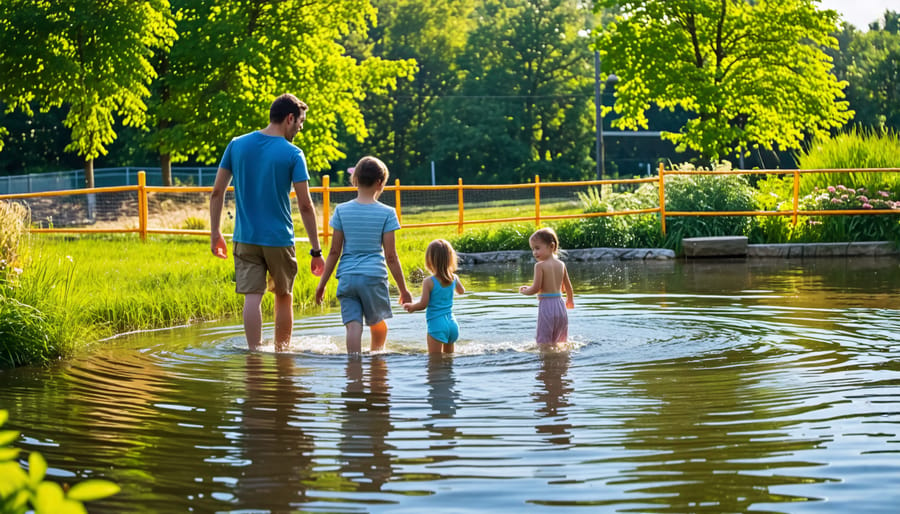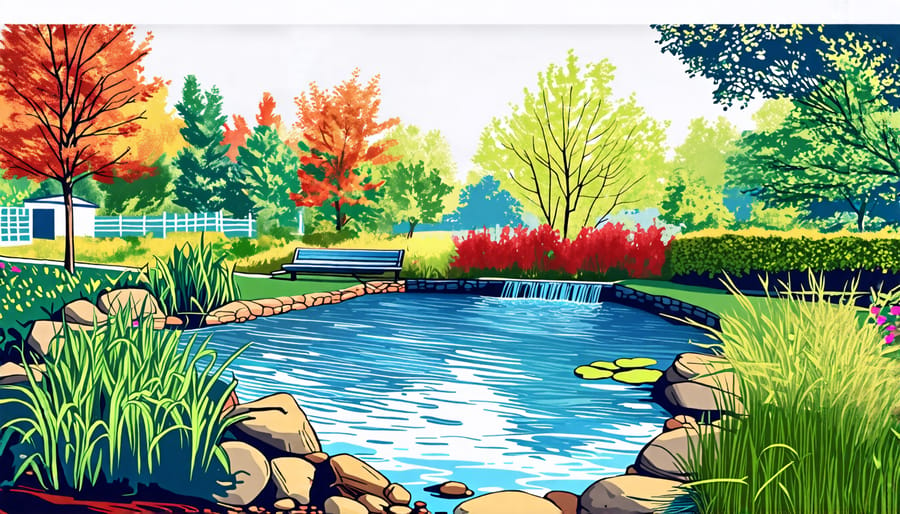
Splash Into Summer: 10 Essential Water Safety Tips for Your Pond Paradise
Always supervise children around water, ensuring they wear properly-fitted life jackets. Establish clear rules for behavior near ponds and pools. Fence off water features, installing self-closing, self-latching gates. Take a CPR class so you’re prepared for emergencies. When water gardening, avoid submerged hazards and slippery surfaces. Regularly check ponds for debris, pump malfunctions, and unhealthy water conditions. Post “No Swimming” signs as needed. Have a well-stocked first-aid kit on hand. Teach kids to swim as early as possible. Stay alert and avoid distractions when supervising water activities.
Tip 1: Secure Your Pond Area
Securing your pond area is crucial to prevent accidents and ensure the safety of children and pets. Installing proper fencing, gates, or natural barriers around the perimeter of your pond will restrict unsupervised access and provide peace of mind. Consider using sturdy materials like wood, metal, or vinyl for your fence, ensuring it is at least 4 feet high to deter climbing. For a more natural look, strategically place large rocks, dense shrubs, or thorny bushes around the pond’s edge. Remember to keep any gates leading to the pond area locked when not in use. If you prefer a DIY approach, you can create a charming rustic fence using reclaimed wood pallets or bamboo poles. Alternatively, a decorative metal garden fence can add an elegant touch while serving as a safety barrier. Always prioritize safety when designing and constructing your pond area barriers to create a secure and enjoyable outdoor space.

Tip 2: Maintain Clear Visibility
Maintaining clear water is crucial for safety, as it allows you to see the bottom and any potential hazards lurking beneath the surface. Regularly skim leaves and debris from the water’s surface, and consider installing a pond skimmer or net to catch floating material before it sinks and decays. Aquatic plants are beautiful additions to your pond, but keep them trimmed and thinned so they don’t impede visibility or create entanglement risks. Remove any dead, damaged, or overgrown foliage promptly. For submerged plants, ensure they don’t grow too tall or dense, obscuring your view of the pond floor. With crystal clear water and well-maintained vegetation, you can relax and enjoy your pond while keeping a watchful eye on swimmers and the overall environment.

Tip 3: Create Shallow Edges
When constructing your pond, create edges that gradually slope into the water rather than plunging straight down. This not only looks more natural but also provides a safer environment. If someone accidentally falls in, a shallow incline allows them to simply stand up and walk out rather than struggling against a steep wall. For existing ponds with problematic drop-offs, you can retrofit the edges by adding gravel or rocks to create a gentler slope. Use a mix of stone sizes to mimic a natural shoreline transition. Aim for a grade no steeper than a 4:1 ratio – meaning the pond depth increases by 1 foot for every 4 feet of horizontal distance. Incorporate marginal plants along this littoral shelf to further stabilize the soil and enhance the aquatic ecosystem. With proper planning and a bit of elbow grease, you can sculpt pond edges that seamlessly blend safety and aesthetics.
Tip 4: Install Safety Devices
Installing safety devices around your pond or water feature can provide extra protection and peace of mind. Pond safety nets are an effective way to prevent accidental falls, especially if you have young children or pets. Life rings and ladders are crucial for quick rescue in case someone does end up in the water. Don’t forget about the wildlife that may visit your pond too – escape ramps for wildlife allow small animals to safely exit the water if they fall in. Consider installing a combination of these devices to create a comprehensive safety system. Look for high-quality, durable products that can withstand outdoor conditions and easily integrate with your pond’s design.
Tip 5: Ensure Stable Footing
Stable footing is crucial around your pond to prevent slips and falls. Opt for textured rocks, anti-slip pavers, or specialized mats designed for wet areas. These materials provide traction, even when wet, ensuring a secure grip for you and your loved ones. Consider strategically placing stepping stones or creating designated pathways with non-slip surfaces leading to and around the pond. Remember, a little extra precaution goes a long way in maintaining a safe and enjoyable pond environment for everyone to enjoy. Don’t let slippery surfaces dampen your outdoor fun – prioritize stable footing for a worry-free water garden experience.
Tip 6: Educate and Supervise
Educating your family about pond safety is crucial, especially when it comes to children. Make sure everyone understands the rules, such as no running near the water’s edge, wearing life jackets, and never swimming alone. Actively supervise kids whenever they’re around the pond, keeping a close eye on their activities. Consider using creative ways to teach pond safety to engage young minds. Turn lessons into games, create colorful visual aids, or set up a reward system for following safety guidelines. By making safety education fun and interactive, children are more likely to remember and adhere to the rules. Regularly reinforce these lessons and lead by example to instill a strong sense of pond safety awareness in your family.

Tip 7: Be Smart with Electricity
Electricity and water don’t mix, so being smart with electrical devices around your pond is crucial. Always use GFCI (ground fault circuit interrupter) outlets for any electrical connections near the water. These outlets will immediately shut off power if they detect a short circuit, potentially preventing electrocution. Keep cords tidy and secure, using cord covers or clips to prevent tripping hazards and keep them away from the water’s edge. Consider using battery-operated or solar-powered devices when possible to minimize electrical risks. If you must use electrical equipment near the pond, ensure it’s rated for outdoor use and keep it as far from the water as practical. Investing in weatherproof electrical boxes and covers can provide an extra layer of protection. Remember, a little electrical safety goes a long way in preventing accidents around your pond.
Tip 8: Prepare for Emergencies
Being prepared for emergencies is crucial when it comes to water safety. Consider taking courses in water rescue skills and CPR so you can respond effectively if someone is in distress. Always keep a well-stocked first aid kit easily accessible near your pond or water feature. Include items like bandages, antiseptic, scissors, and a thermal blanket. It’s also wise to have a charged phone nearby to quickly call for help in case of an emergency. By being proactive and prepared, you can enjoy your pond with greater peace of mind.
Tip 9: Manage Water Quality
Poor water quality can pose serious safety risks to people, pets, and wildlife. Stagnant, murky water can harbor harmful bacteria and parasites, leading to illnesses. To keep your pond safe and healthy, regularly remove debris like fallen leaves and branches. Consider installing a filtration system to maintain water clarity and oxygenation. Test the water periodically for proper pH, ammonia, and nitrite levels, making adjustments as needed. For larger ponds, consider beneficial bacteria treatments to break down organic matter and keep the ecosystem balanced. Aquatic plants can also help absorb excess nutrients and filter the water naturally. By staying on top of pond maintenance and water treatments, you’ll ensure a safe and inviting environment for all to enjoy.
Tip 10: Schedule Regular Inspections
Regular pond inspections are crucial for maintaining a safe water feature. Set a schedule to routinely check for potential hazards like damaged electrical components, leaks, unstable edges, or excessive algae growth. Look for signs of erosion, loose stones, or overgrown vegetation that could pose risks. Inspect any pumps, filters, or fountains to ensure they’re functioning properly and safely installed. Documenting your findings with a printable pond safety checklist can help you stay organized and address issues promptly. By being proactive with inspections, you’ll catch small problems before they escalate, keeping your pond safe and enjoyable for all.
Conclusion
Pond and water garden safety is paramount to ensure a worry-free and enjoyable outdoor experience for you and your loved ones. By implementing these ten essential water safety tips, you can create a secure and beautiful aquatic oasis right in your own backyard. From proper fencing and covering to regular maintenance and supervision, each precaution plays a vital role in minimizing risks and preventing accidents. As you embrace the joys of water gardening, remember that a proactive approach to safety is the key to maintaining a tranquil and inviting pond environment throughout the summer months and beyond. So, go ahead and dive into the wonders of your water garden with confidence, knowing that you’ve taken the necessary steps to prioritize safety and well-being in your outdoor sanctuary.
